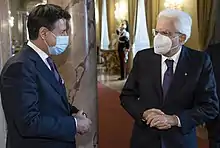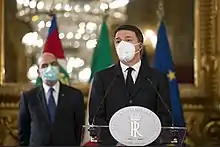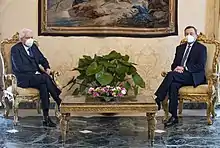2021 Italian government crisis
The 2021 Italian government crisis is an ongoing political event in Italy that occurred in January 2021. It includes the events that follow the announcement of Matteo Renzi, leader of Italia Viva (IV) and former Prime Minister, that he would revoke IV's support to the government of Giuseppe Conte.[1]
 Mario Draghi accepting the task of forming a new government | |
| Date | 13 January 2021 – ongoing |
|---|---|
| Location | Italy |
| Type | Parliamentary crisis |
| Cause | Withdrawal of Italia Viva's support to Giuseppe Conte's government |
| Participants | Five Star Movement League Forza Italia Democratic Party Brothers of Italy Italia Viva Free and Equal Europeanists For the Autonomies Mixed Group |
| Outcome |
|
On 18 and 19 January, Renzi's party abstained and the government won the key confidence votes in the Chamber and in the Senate, but it failed in reaching the absolute majority in the Senate.[2] On 26 January, Prime Minister Conte resigned from his office, prompting President Sergio Mattarella to start new consultations for the formation of a new government.
Background
In September 2019, a new government was formed between the Five Star Movement (M5S), the Democratic Party (PD) and Free and Equal (LeU), with the independent university professor, Giuseppe Conte, at its head.[3][4][5][6] However, on 16 September, a few days from the investiture vote, in an interview with la Repubblica, former Prime Minister Matteo Renzi announced his intention to leave the PD, launching a new centrist and liberal party named Italia Viva (IV).[7][8] In the interview, he confirmed also the support to Conte's government.[9] Two ministers, Teresa Bellanova and Elena Bonetti, and one undersecretary, Ivan Scalfarotto, followed Renzi to his new movement.[10]
Political crisis

Between December 2020 and January 2021, discussions arose within the government coalition between Conte and Matteo Renzi, former Prime Minister and leader of Italia Viva.[11] Renzi called for radical changes to the government's economic recovery plans after the COVID-19 pandemic, and also demanded that Conte cede his mandate over the secret services coordination task.[12] During his end-of-year press conference, Conte declined Renzi's requests, asserting that he still had a majority in the Parliament.[13]
On 13 January, during a press conference, Renzi announced the resignation of IV's two ministers, effectively triggering the collapse of Conte's government.[14] Renzi stated: "We will not allow anyone to have full powers, we have started this government not to give them to Salvini. There is a dramatic emergency to face but it cannot be the only element that keeps the government alive. Responding to the pandemic means having the desire and need to unblock construction sites and act on industrial policies. There is a reason if Italy is the country with the highest number of deaths and GDP that collapses."[15]

During a late-night Council of Ministers, Conte heavily attacked Renzi, stating that "Italia Viva has assumed the serious responsibility of opening a government crisis. I am sincerely regretted for the considerable damage that has being produced for our country due to a government crisis in the midst of a pandemic. If a party forces its ministers to resign, the gravity of this decision cannot be diminished."[16] The Prime Minister was soon backed by the secretary of the Democratic Party, Nicola Zingaretti, who labeled the crisis as a "very serious mistake against Italy" and "an act against our country",[17] while the Minister of Culture, Dario Franceschini, head of the democratic delegation in the government, stated: "Whoever attacks the Prime Minister, attacks the entire government and Giuseppe Conte is serving the country with passion and dedication in the most difficult moment of our republican history".[18] The Minister of Foreign Affairs and former leader of the M5S, Luigi Di Maio, described Renzi's decision as a "reckless move", asserting that Prime Minister Conte and President Sergio Mattarella are the two only pillars of Italy in a moment of uncertainty;[19] while Roberto Speranza, Minister of Health and de facto leader of Free and Equal (LeU), said that Conte "has served the country with discipline and honor", adding that LeU still supported him.[20] Moreover, many other prominent members of the cabinet like Stefano Patuanelli, Alfonso Bonafede, Vincenzo Spadafora and Riccardo Fraccaro expressed their support to Conte.[21] The opposition leaders, Matteo Salvini and Giorgia Meloni, immediately asked for snap elections.[22]
On 15 January, Conte announced that he would report about the government crisis in the parliament in the following week. On that occasion, he would also seek for a confidence vote to confirm the parliamentary support for the government.[23]
Confidence vote
On 18 January 2021, the government won the vote of confidence in the Chamber of Deputies with 321 votes in favour, 259 against and 27 abstentions.[24][25] On the following day the government won a vote of confidence in the Senate with 156 votes in favor, 140 against and 16 abstentions;[26][27] however, the cabinet was not able to reach the absolute majority in the house.[28]
In both houses of Parliament, the Italia Viva groups abstained. The government also gained support from a few MPs who did not belong to the majority, such as three MPs from Forza Italia, one from More Europe, and others from the Mixed group.
Confidence votes for Conte II Cabinet | |||
|---|---|---|---|
| House of Parliament | Vote | Parties | Votes |
| Chamber of Deputies (Voting: 607 of 630, Majority: 316) |
M5S (188), PD (93), LeU (12), CD (11), Mixed Group–Ind. (8), SVP–PATT (4), MAIE (3), IV (1), FI (1) | 321 / 607 | |
| Lega (125), FI (85), FdI (31), NcI–USEI–C! (9), +EU–Action (4), Mixed Group–Ind. (3), AP–PSI (2) | 259 / 607 | ||
| Abstention | IV (27) | 27 / 607 | |
| Senate of the Republic (Voting: 312 of 321, Majority: 161) |
M5S (91), PD (35), Aut (8), Mixed Group–Ind. (8), LeU (6), MAIE (4), FI (2), PSI (1), +EU–Action (1) | 156 / 312 | |
| Lega (62), FI–UDC (49), FdI (19), Mixed Group–Ind. (5), IdeA–C! (3), +EU–Action (2) | 140 / 312 | ||
| Abstention | IV (16) | 16 / 312 | |
Resignation of Giuseppe Conte and consultations

On 26 January, after a few days of inconclusive negotiations with centrist and independent senators to regain an absolute majority in the Senate, Conte resigned as Prime Minister.[29][30][31] On the following day, a new parliamentary group, known as Europeanists, was formed in the Senate in support of Conte.[32] The group was composed by members of the Associative Movement Italians Abroad (MAIE) and other centrist and liberal senators.
On 27 January, the consultations with President Sergio Mattarella for the formation of a new cabinet began at the Quirinal Palace, meeting the presidents of the two houses, senator Elisabetta Casellati and honourable Roberto Fico.[33]
On 28 January, President Mattarella met the delegations of For the Autonomies, Free and Equal and the new-born Europeanists, which confirmed their supports to Conte, as well as the independent MPs of the Mixed Group.[34] Matteo Renzi, which was received in the afternoon along with Italia Viva's delegation, opened to a new government with the same old majority, but he opposed to give the task of forming a new cabinet to Conte,[35] while Nicola Zingaretti, leader of the PD, stressed the necessity of starting a new government with Conte at its head.[36]
On 29 January, the centre-right coalition, composed by the League (Lega), Brothers of Italy (FdI), Forza Italia (FI) and other conservative minor parties, was received by President Mattarella. Matteo Salvini, leader of the League, asked for snap election, otherwise he added that, at specific conditions, the centre-right could support a national unity government.[37][38] The consultations ended with the Five Star Movement (M5S), whose leader, Vito Crimi, confirmed the support to Prime Minister Conte and opened to a return of Italia Viva within the majority.[39] This statement caused the immediate reaction of Alessandro Di Battista, leader of the anti-establishment wing of the M5S, which threatened to exit from the party if Renzi will return to government.[40]
Further negotiations and Draghi government

At the end of the consultations, Mattarella gave the President of the Chamber, Roberto Fico, the task of verifying the possibility of a new government with the same majority of the previous one, composed by M5S, PD, IV and LeU.[41]
On the deadline day of 2 February, IV broke away from the majority due to disagreements on both platform and cabinet members, leading Fico to head back to Mattarella with a negative outcome.[42] Following the unsuccessful government formation, Mattarella invited Mario Draghi for the next day at the Quirinal Palace with the intention to offer him the task to form a technocratic government.[43][44] On 3 February, Draghi officially accepted with reservation the task of forming a new cabinet and started the consultations with the presidents of the two houses.[45] On the same day, he also met Giuseppe Conte,[46] who officially endorsed him on the following day.[47]
References
- Conte offre un patto, Renzi ritira le ministre. La crisi è servita, Huffington Post Italia
- Italy's Conte wins Senate vote to keep fragile government afloat: final tally, Reuters
- "Grasso, possibile intesa M5s-Pd-Leu - Ultima Ora". Agenzia ANSA. 19 August 2019. Archived from the original on 19 August 2019. Retrieved 28 August 2019.
- "Conte wins crucial support for new Italian govt coalition". Washington Post. Archived from the original on 28 August 2019. Retrieved 28 August 2019.
- "C'è l'accordo tra M5s e Pd. Governo giallorosso ai nastri di partenza". Agi. Archived from the original on 28 August 2019. Retrieved 28 August 2019.
- "Governo, Conte e i ministri hanno giurato. Gentiloni in pole per successione a Moscovici". Repubblica.it. 5 September 2019. Archived from the original on 5 September 2019. Retrieved 5 September 2019.
- "Renzi lascia il Pd: "Uscire dal partito sarà un bene per tutti. Anche per Conte"". rep.repubblica.it.
- Politica, Redazione (17 September 2019). "Renzi: "Il nome della nuova sfida che stiamo per lanciare sarà Italia viva"". Corriere della Sera. Archived from the original on 24 September 2019. Retrieved 2 October 2019.
- "Matteo Renzi lascia il Pd e fonda nuovo partito: telefona a Conte e annuncia l'addio al Pd, Le ragioni della svolta in una intervista a Repubblica". Repubblica.it. 16 September 2019. Archived from the original on 2 October 2019. Retrieved 2 October 2019.
- "L'iniziativa. Renzi saluta il Pd e lancia "Italia viva". "Siamo 40 in Parlamento"". www.avvenire.it. 17 September 2019. Archived from the original on 2 October 2019. Retrieved 2 October 2019.
- A un passo dalla crisi di governo: Renzi pronto a ritirare le ministre. Ecco gli scenari possibili, Open Online
- Italian government totters as Conte, Renzi divide deepens, Reuters
- Governo, Conte sfida Renzi: “Se si sfila andiamo in aula. Sul Recovery non va bene: dobbiamo correre”, la Repubblica
- Meredith, Sam; Amaro, Silvia (13 January 2021). "Italy's government in crisis after former PM pulls support for ruling coalition". CNBC.com. CNBC. CNBC International. Retrieved 13 January 2021.
- Matteo Renzi annuncia dimissioni ministre IV e attacca il governo, ANSA
- La crisi di governo, Conte in Cdm: "Grave responsabilità Iv, danno a Paese". Zingaretti: "Crisi con 500 morti, da Iv atto gravissimo contro l'Italia", la Repubblica
- Crisi di governo, Zingaretti: «Un atto gravissimo contro l'Italia». Salvini e Meloni: ora elezioni, Corriere della Sera
- Crisi, il governo fa quadrato intorno a Conte. Franceschini: “Un attacco a tutti noi”. Speranza: “Avanti al suo fianco”. Fraccaro: “Inconcepibile”, Il Fatto Quotidiano
- "Di Maio: "Da Renzi gesto irresponsabile, strade divise ora"". lastampa.it (in Italian). 14 January 2021. Retrieved 14 January 2021.
- In questi mesi Giuseppe Conte ha servito il Paese con disciplina ed onore. Avanti al suo fianco, Roberto Speranza – Twitter
- Il Pd e il Movimento Cinque Stelle vogliono andare avanti con Conte, Fanpage
- "Giorgia Meloni e Matteo Salvini: «Elezioni subito». La leader Fdi: «Governo allo sfascio»". www.ilmessaggero.it (in Italian). Retrieved 14 January 2021.
- "Conte cerca il voto in Aula. Ora è caccia ai 'costruttori'. Fronda nel M5s - Politica". Agenzia ANSA (in Italian). 14 January 2021. Retrieved 25 January 2021.
- Staff, Reuters (18 January 2021). "Italy PM Conte comfortably wins lower house confidence vote". Reuters. Retrieved 18 January 2021.
- Crisi di governo, via libera della Camera alla fiducia a Conte con 321 voti. Il premier: "Strappo con Iv incancellabile". Polverini vota sì e lascia Forza Italia, la Repubblica
- "Italian PM Giuseppe Conte's government survives Senate confidence vote". euronews. 19 January 2021. Retrieved 19 January 2021.
- Crisi di governo, sì del Senato alla fiducia con 156 voti. Ma scoppia il caso Ciampolillo. Sì dei forzisti Rossi e Causin. Meloni e Salvini: "Ci rivolgeremo al Colle", la Repubblica
- Il Senato vota la fiducia a Conte: il Governo ha la maggioranza relativa con 156 sì, Fanpage
- Legorano, Giovanni (25 January 2021). "Italian Prime Minister Resigns Amid Struggle Over How to Revive Economy From Covid-19". The Wall Street Journal. Retrieved 25 January 2021.
- Crisi di governo, Conte si dimette: "Grazie a ogni singolo ministro". Alle 12 sale al Quirinale e spera nel 'Ter'. La regia passa a Mattarella, la Repubblica
- Italy's Prime Minister Giuseppe Conte to resign, BBC
- Al Senato nasce il gruppo dei responsabili: si chiama "Europeisti", TGCOM 24
- Al via le consultazioni, Mattarella saluta i giornalisti, ANSA
- Governo, Causin (Europeisti): “Conte è elemento di attrazione, non escludiamo un partito. Italia Viva? Fa la schifiltosa ma è nata come noi”, Il Fatto Quotidiano
- Governo: secondo giorno di consultazioni. Renzi: 'Dopo i veti ci dicano se ci vogliono', ANSA
- Consultazioni, Zingaretti: "Pd sostiene incarico a Conte, è punto di sintesi", la Repubblica
- "Mattarella: "Adotterò un'iniziativa immediata". E convoca il presidente Fico per un mandato esplorativo". lastampa.it (in Italian). 29 January 2021. Retrieved 29 January 2021.
- Centrodestra a Mattarella: incarico esplorativo al presidente Casellati, TgCom 24
- Crimi “Pronti a confronto anche con Italia Viva, ma serve lealtà”, Il Tempo
- Governo, alleanza con Renzi? Di Battista ai M5S: «Arrivederci e grazie», Corriere della Sera
- Mattarella: “Possibile conferma della maggioranza attuale, va verificata”. Fico convocato al Quirinale, Il Fatto Quotidiano
- "La vecchia maggioranza non si è messa d'accordo" (in Italian). Il Post. 2 February 2021. Retrieved 2 February 2021.
- "Ex-ECB chief Mario Draghi asked to form Italy's next government". euronews. 3 February 2021. Retrieved 3 February 2021.
- "Mattarella sceglie un governo del presidente e convoca Mario Draghi: "Voto non opportuno con l'emergenza, serve pienezza delle funzioni"" (in Italian). Il Fatto Quotidiano. 2 February 2021. Retrieved 2 February 2021.
- Crisi governo, Draghi accetta l'incarico: "Vincere pandemia e rilanciare il Paese"., Sky Tg24
- Governo, Draghi incaricato. Colloquio di un'ora con Conte. Crimi: 'Ipotesi voto Rousseau non da trascurare', ANSA
- Giuseppe Conte scende in campo. E si autodichiara federatore, Huffington Post